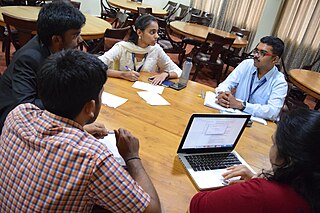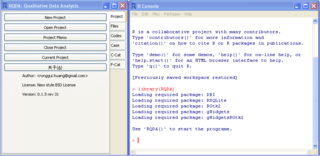Related Research Articles

A focus group is a group interview involving a small number of demographically predefined participants. Their reactions to specific researcher/evaluator-posed questions are studied. Focus groups are used in market research to better understand people's reactions to products or services or participants' perceptions of shared experiences. The discussions can be guided or open. In market research, focus groups can explore a group's response to a new product or service. As a program evaluation tool, they can elicit lessons learned and recommendations for performance improvement. The idea is for the researcher to understand participants' reactions. If group members are representative of a larger population, those reactions may be expected to reflect the views of that larger population. Thus, focus groups constitute a research or evaluation method that researchers organize to collect qualitative data through interactive and directed discussions.
The following outline is provided as an overview of and topical guide to software engineering:

Qualitative research is a type of research that aims to gather and analyse non-numerical (descriptive) data in order to gain an understanding of individuals' social reality, including understanding their attitudes, beliefs, and motivation. This type of research typically involves in-depth interviews, focus groups, or field observations in order to collect data that is rich in detail and context. Qualitative research is often used to explore complex phenomena or to gain insight into people's experiences and perspectives on a particular topic. It is particularly useful when researchers want to understand the meaning that people attach to their experiences or when they want to uncover the underlying reasons for people's behavior. Qualitative methods include ethnography, grounded theory, discourse analysis, and interpretative phenomenological analysis. Qualitative research methods have been used in sociology, anthropology, political science, psychology, communication studies, social work, folklore, educational research, information science and software engineering research.

Grounded theory is a systematic methodology that has been largely applied to qualitative research conducted by social scientists. The methodology involves the construction of hypotheses and theories through the collecting and analysis of data. Grounded theory involves the application of inductive reasoning. The methodology contrasts with the hypothetico-deductive model used in traditional scientific research.
This is an alphabetical list of articles pertaining specifically to software engineering.
Axial coding is the breaking down of core themes during qualitative data analysis.
ATLAS.ti is a computer-assisted qualitative data analysis software that facilitates analysis of qualitative data for qualitative research, quantitative research, and mixed methods research.
In the social sciences, coding is an analytical process in which data, in both quantitative form or qualitative form are categorized to facilitate analysis.
NVivo is a qualitative data analysis (QDA) computer software package produced by Lumivero. NVivo is used across a diverse range of fields, including social sciences such as anthropology, psychology, communication, sociology, human geography as well as fields such as forensics, tourism, criminology and marketing.
Transana is a software package used to analyze digital video or audio data. Transana used to be a GPL licensed software, but has become proprietary software in recent releases.

RQDA is an R package for computer assisted qualitative data analysis or CAQDAS. It is installable from, and runs within, the R statistical software, but has a separate window running a graphical user interface. RQDA's approach allows for tight integration of the constructivist approach of qualitative research with quantitative data analysis which can increase the rigor, transparency and validity of qualitative research.
Computer-assistedqualitative data analysis software (CAQDAS) offers tools that assist with qualitative research such as transcription analysis, coding and text interpretation, recursive abstraction, content analysis, discourse analysis, grounded theory methodology, etc.
CAT or Coding Analysis Toolkit was a web-based suite of CAQDAS tools. It is free and open source software, and is developed by the Qualitative Data Analysis Program of the University of Pittsburgh. According to the CAT website, the tool was decommissioned on September 13, 2020.
MAXQDA is a software program designed for computer-assisted qualitative and mixed methods data, text and multimedia analysis in academic, scientific, and business institutions. It is being developed and distributed by VERBI Software based in Berlin, Germany.
The Center for Qualitative Psychology was founded in October 1999 in the department of educational psychology at the University of Tübingen to promote qualitative research methods in psychology. The centre is also committed to supporting qualitative methods for social research in education, sociology, philosophy, medicine, ethnography, politics, etc.
Aquad is open source computer-assisted qualitative data analysis software (CAQDAS). It supports analysis of text, audio, video, and graphical data.
The Qualitative Data Analysis Program (QDAP) was founded in 2005 at the University of Pittsburgh in the University Center for Social and Urban Research. QDAP is a fee-for-service research laboratory that develops software and methods to support multi-coder annotation projects. In 2008, QDAP-UMass was opened at the University of Massachusetts Amherst. Researchers at QDAP developed the Coding Analysis Toolkit (CAT), which is a free, open source, web-based CAQDAS package.

KH Coder is an open source software for computer assisted qualitative data analysis, particularly quantitative content analysis and text mining. It can be also used for computational linguistics. It supports processing and etymological information of text in several languages, such as Japanese, English, French, German, Italian, Portuguese and Spanish. Specifically, it can contribute factual examination co-event system hub structure, computerized arranging guide, multidimensional scaling and comparative calculations. Word frequency statistics, part-of-speech analysis, grouping, correlation analysis, and visualization are among the features offered by KH Coder.

Quirkos is a CAQDAS software package for the qualitative analysis of text data, commonly used in social science. It provides a graphical interface in which the nodes or themes of analysis are represented by bubbles. It is designed primarily for new and non-academic users of qualitative data, to allow them to quickly learn the basics of qualitative data analysis. Although simpler to use, it lacks some of the features present in other commercial CAQDAS packages such as multimedia support. However, it has been proposed as a useful tool for lay and participant led analysis and is comparatively affordable. It is developed by Edinburgh, UK based Quirkos Software, and was first released in October 2014.
Marilyn Gray Richards is an Australian social scientist and writer who, with computer scientist Tom Richards, developed the software analysis packages NUD*IST and NVivo.
References
- ↑ Bénel A., Lejeune Chr., 2009, Humanities 2.0. Document, interpretation and intersubjectivity in the digital age, International Journal of Web-Based Communities, 5, 4, p.562-576
- ↑ Lejeune Chr., 2010, Cassandre, un outil pour construire, confronter et expliciter les interprétations, in: Beauvais M., Clénet J., Actes du 2ème colloque international francophone sur les méthodes qualitatives
- ↑ Rojas de Francisco L., López-Sintas J., García-Álvarez E., 2016, Social leisure in the digital age, Society and Leisure, 39, 2
- ↑ Dumont V., 2010, Des intentions aux routines d'un réseau de santé, Cédric R., d'Arripe A., Communication et santé : enjeux contemporains, p. 29-40
- ↑ Constantinidis C., Nelson T., 2009, Integrating Succession and Gender Issues from the Perspective of the Daughter of Family Enterprise: A Cross-National Investigation, International Management, 14, 1, p. 43-54
- ↑ Beuker L., De Cia J., Dervaux A., Orianne J.-F., Pichault F., 2016, Analyse qualitative interdisciplinaire du discours de travailleurs à l'aide d'un logiciel collaboratif : le cas de la flexicurité, Recherches Qualitatives, 35, 1, p. 29-55
- ↑ De Maeyer J., 2012, The journalistic hyperlink: Prescriptive discourses about linking in online news, Journalism Practice, 6, 5–6, p. 692-701
- ↑ Brunet S., Delvenne P., 2010, Politique et expertise d’usage en situation de haute incertitude scientifique : application de la méthodologie des Focus groups au risque électromagnétique, Cahiers de Sciences politiques de l'ULg, 17
- ↑ Cahier J.-P., Brébion P., Salembier P., 2016, Using and Supporting Explicit Viewpoints in Territorial Participatory Design Meetings, European Conference on Knowledge Management, p. 136-145
- ↑ Evers J., Silver C., Mruck K. & Peeters B., 2011, Introduction to the KWALON Experiment: Discussions on Qualitative Data Analysis Software by Developers and Users, Forum Qualitative Sozialforschung / Forum: Qualitative Social Research, 12, 1.
- ↑ Gibbs, G., 2013, Using software in qualitative analysis, in Flick, U. (ed.) The SAGE handbook of qualitative data analysis
- ↑ di Gregorio, S., 2011, Comment: KWALON Conference: Is Qualitative Software Really Comparable? Reflections on "the Experiment": An "Expert" View, Forum Qualitative Sozialforschung / Forum: Qualitative Social Research, 12, 1.
- ↑ Geisler, C., 2016, Current and Emerging Methods in the Rhetorical Analysis of Texts. Toward an Integrated Approach, Journal of Writing Research, 7, 3.
- ↑ Gilbert, L., Jackson K. & di Gregorio S., 2014, Tools for Analyzing Qualitative Data: The History and Relevance of Qualitative Data Analysis Software, in Spector M. et al. (dir.), Handbook of Research on Educational Communications and Technology, New York, Springer, p. 221-236
- ↑ Zhou, C., Lejeune, Chr. and Bénel, A., 2006, Towards a standard protocol for community-driven organizations of knowledge in Ghodous, P., Dieng-Kuntz R. and Loureiro G., Leading the Web in Concurrent Engineering, IOS Press, Amsterdam, p. 438-449
- ↑ Lejeune, Chr., 2011, From Normal Business to Financial Crisis... and Back Again. An Illustration of the Benefits of Cassandre for Qualitative Analysis. Forum Qualitative Sozialforschung / Forum: Qualitative Social Research, 12, 1.